- Home
- Orhan Pamuk
Istanbul Page 6
Istanbul Read online
Page 6
Your Highness, on Saturday I, your humble servant, sent my manservant to collect my monthly salary [and] they told him it’s been stopped.… After seeing so much kindness from Your Highness, I could not believe this order came from you.… This gossip, it must be jealous gossip … it’s because they see how much Your Highness loves her subjects.… Winter is coming, I am going to Beyoğlu, but how will I go? I don’t have a single coin to my name. The landlord wants the rent, we need coal, wood, things for the kitchen, and my girl has smallpox, the doctor wants 50 kurus, and where will I find it? No matter how many times I plead, no matter how much I pay to travel by boat and by road, still I’ve not received a favorable response.… I entreat you, I’ve been left without a coin to my name.… Your Highness, I implore you not to abandon me.
After Hatice Sultan had failed to respond to his final entreaties, Melling prepared to return to Europe and began to think of other ways to make money. It seems to have occurred to him that he might profit from his close ties to the palace by turning the large detailed gouaches he had been painting for some time into a book of engravings. With the help of Pierre Rufin, the French chargé d’affaires in Istanbul and a renowned orientalist, he began to correspond with publishers in Paris. Although Melling returned to Paris in 1802, it would be seventeen years before the book was published (when he was fifty-six); he was able to work with the best engravers of his age, and from the very beginning there was a strong commitment to be as faithful to the original paintings as the form allowed.
When we look at the forty-eight engravings in this enormous book, what strikes us first is his precision. As we survey these landscapes from a lost world, enjoying the fine architectural detail and the skillful manipulation of perspective, our desire for versimilitude is fully satisfied. This is true even of the tableau set inside the harem—of all the engravings the most fantastical—which still partakes of a draftsman’s precision as it explores the possibilities of “Gothic” perspective. Depicting the scene with a dignity and elegance far removed from the usual lurid western sexual fantasies of the harem, it has a seriousness that convinces even the Istanbul viewer. Melling balances the painting’s almost academic air with the humanizing details he slips into the edges. On the ground floor of the harem, we see two women standing next to the far wall; they are embracing lovingly, lips pressed to lips, but—unlike other western painters—Melling does not exaggerate these women or sentimentalize their intimacy by placing them at the painting’s center.
In Melling’s Istanbul landscapes it is almost as if there is no center. This effect, and his attention to detail, may be what draws me to the Istanbul he depicts. On a map placed at the end of his book, Melling shows where each of his forty-eight tableaux is located and indicates the angle from which they are being viewed, thus suggesting an obsessive concern with point of view, but as with Chinese scrolls or some camerawork in Cinemascope, the point of view seems to be endlessly shifting. Because Melling never places human dramas at the center of his paintings, to see them is for me rather like driving along the Bosphorus when I was a child: one bay suddenly emerging from behind another, with every bend in the shore road bringing a view from a surprising new angle. And so it is, as I leaf through this book, that I begin to think of Istanbul as center-less and infinite and feel myself inside one of the tales I loved so much as a boy.
To look at Melling’s Bosphorus views is not just to conjure up the Bosphorus as I first saw it: the slopes and valleys and hills that were then still bare, a purity almost impossible to recall for all the ugly construction that would crop up over the next forty years. As I leaf through his book, the very thought that this lost heaven has bequeathed to me even a few of the landscapes and houses I’ve known in my own lifetime produces a kind of rapture. Here, at the point where melancholy mixes with joy, is where I notice the little continuities discernible only to those very familiar with the Bosphorus. When the time comes to leave that lost heaven to reenter my present life, the effect operates in the other direction too. Yes, I’ll tell myself, just when you’re leaving Tarabya Bay and the sea is no longer calm, suddenly the north wind ripping down from the Black Sea ruffles its surface, and on the crests of its hurried, nervous waves there are the same small, angry, impatient bubbles that Melling shows in his painting. Yes, in the evenings, the woods on the hills over Bebek recede into just this sort of darkness, and only someone like me or someone like Melling, someone who has lived here for at least ten years, would know this darkness for one that comes from within.
Cypress trees figure prominently in traditional Islamic gardens and Islamic paintings of heaven, and in Melling’s paintings they serve much the same function as they do in Persian miniatures: standing sedately like so many dark stains, bringing the painting into poetic harmony. When Melling is painting the curves and curls of the Bosphorus pines, he refuses to go the way of other western artists, who exaggerated their branches to create dramatic tension or provide a frame. In this sense, Melling is like the miniaturists: Just as he sees the trees from a distance, so too does he see his people, even at moments of heightened emotion. True, he is not very good at depicting human gestures, and, also true, his placement of boats and ships on the Bosphorus is sometimes clumsy (they look as if they’re coming directly toward us). In spite of the great attention he paid to buildings and figures, he sometimes gets them childishly out of proportion, but it is in these very defects that we encounter Melling’s poetry, and it is his poetic vision that makes him a painter who speaks to modern-day İstanbullus. When we notice that the many women in Hatice Sultan’s palace and the sultan’s harem have faces so similar they could be sisters, it’s the naïve purity of Melling’s vision that makes us smile and his affinity with the miniaturists that makes us proud.
Melling gives us a sense of the city’s golden age with a fidelity to architectural, topographical, and everyday detail that other western artists, influenced by western ideas of presentation, never achieved. In his map he indicates the point in Pera from which he painted Kızkulesi and Üsküdar—a point no more than forty paces from the study in Cihangir where I am writing these lines. When he painted Topkapı Palace, he was viewing it through the windows of a coffeehouse on the slopes of Tophane, and he painted his Istanbul skyline on the slopes of Eyüp. In these views we know and love intimately, he gives us a vision of heaven in which the Ottomans no longer think of the Bosphorus as a string of Greek fishing villages but as a place they have claimed for themselves. As architects respond to the pull of the West, they reflect a mood in which purity has been abandoned. It’s because Melling gives us such precise images of a culture in transition that the Ottoman Empire before Selim III seems so very distant.
Marguerite Yourcenar once wrote of inspecting Piranesi’s eighteenth-century engravings of Venice and Rome “with a magnifying glass in hand”; I like to do the same with the figures that inhabit Melling’s Istanbul landscapes. I might begin with the picture of Tophane Square and Tophane Fountain—which the artist visited frequently—subjecting it to obsessive scrutiny, down to the centimeter. I’ll look at the watermelon seller on the left and observe with pleasure that today’s watermelon sellers display their wares in just the same way. Thanks to Melling’s attentiveness, we can see that Tophane Fountain was elevated above the street in Melling’s time; today, long after the roads around it were paved with cobblestones and then covered with layer after layer of asphalt, the fountain sits in a pit. In every garden, on every street, we see mothers holding tightly to their children’s hands (fifty years later, Théophile Gautier posited that Melling preferred painting women with children, finding them less unsettling and more deserving of respect than women walking alone).
Melling’s city, like ours, teems with peddlers hawking clothes and food who display their wares on three-legged tables. A youth is fishing from the old fishing station at Beşiktaş (and loving Melling as much as I do, I am not going to say that the sea at Beşiktaş is never quite so calm as he depicts it); beside this youth, onl
y five paces away, are the two mysterious men who appear on the cover of a Turkish edition of The White Castle; on the hills of Kandilli is a man with a dancing bear and an assistant, shaking a tambourine; in the center of Sultanahmet Square (the Hippodrome, according to Melling), seemingly unmoved by the crowds and the monuments, in the manner of all true İstanbullus, there is a man walking slowly alongside his burdened donkey; sitting in the same picture, with his back to the crowd, is a man selling the sesame rolls we still call simits, and his three-legged table is the same as the three-legged tables some simit sellers still use today.
No matter how great the monument or how magnificent the view, Melling never lets them dominate his paintings. Although he loves perspective as much as Piranesi, Melling’s paintings are never dramatic. (Not even when the boatmen of Tophane engage in a quarrel!) What crushes people in Piranesi’s engravings is the dramatic violence of his architectural perpendiculars; these reduce his figures to freaks, beggars, cripples, and ragged grotesques. Melling’s landscapes give us a sense of horizontal movement. Nothing jumps at the eye. By exploiting the endless possibilities of Istanbul’s geography and architecture, he offers us a wondrous paradise and invites us to wander through it at our leisure.
By the time he left, Melling had spent half his life here, so it would be wrong to see his time in Istanbul as an education. These were the years when he found out what he was made of; it was here that he began to earn his living and, while earning his living, to produce his first works. Seeing the details and materials of Istanbul as its own inhabitants saw them, Melling was not interested in exoticizing or orientalizing his scenes in the manner of so many other celebrated painters and engravers, like William Henry Bartlett (The Beauties of the Bosphorus, 1835), Thomas Allom (Constantinople and the Scenery of the Seven Churches of Asia Minor, 1839), and Eugène Flandin (L’Orient, 1853), to name a few. Melling saw no need to fill his paintings with figures from A Thousand and One Nights; the Romantic Movement, now in full flower in the West, did not interest him at all; he never sought to add to the atmosphere by playing with light and shadow, mist and clouds, or to portray the city and its people as rounder, wavier, plumper, poorer, or more “arabesque” than they really were.
Melling’s is an insider’s eye. But because the İstanbullus of his time did not know how to paint themselves or their city—indeed, had no interest in doing so—the techniques he brought with him from the West still give these candid paintings a foreign air. Because he saw the city like an İstanbullu but painted it like a clear-eyed Westerner, Melling’s Istanbul is not only a place graced by hills, mosques, and landmarks we can recognize, it is a place of sublime beauty.
CHAPTER EIGHT
My Mother, My Father, and Various Disappearances
My father often went to faraway places. We would not see him for months on end. Strangely, we hardly noticed his absence until he’d already been gone for some time. By then, we were already accustomed to it—rather in the way you might realize belatedly that a seldom-used bicycle has been lost or stolen or that a classmate who has not been to school for some time is not coming back. No one ever explained why our father wasn’t with us, and neither did anyone tell us when to expect his return. It did not occur to us to press for information; because we lived in a big and crowded apartment building surrounded by uncles, aunts, my grandmother, cooks, and maids, it was easy to pass lightly over his absence without stopping to question it, and it was almost as easy to forget he wasn’t there. Sometimes we would feel the sadness of the circumstance we’d not quite forgotten in the excessive warmth of our maid Esma Hanım’s embrace, in the way my grandmother’s cook, Bekir, read too much into something we’d said, and in my Uncle Aydın’s excessive bravado during a Sunday morning spin along the Bosphorus in his ’52 Dodge.
Sometimes, too, I would sense, from the way my mother spent her mornings talking endlessly on the phone to my aunts, her friends, and her own mother, that something was wrong. My mother would be wearing her long cream-colored robe with the red carnations; as she sat with one leg crossed over the other, the robe would fall to the floor in a cascade of folds that caused me confusion; I could see her nightgown as well as her beautiful skin, and I could see her beautiful neck, and I’d want to climb onto her lap and nestle up to her, get closer to that beautiful triangle between her hair, her neck, and her breasts. As my mother told me herself years later, after a fierce mealtime argument with my father, I actually enjoyed the air of disaster that descended on our family and our house when she and my father quarreled.
While I waited for my mother to notice me, I would sit at her dressing table and fiddle with her perfume bottles, lipsticks, fingernail polish, colognes, rose water, and almond oils; I would rummage through the drawers and play with the assortment of tweezers, scissors, nail files, eyebrow pencils, brushes, combs, and various other sharp-pointed instruments; I’d look at the baby photographs of me and my brother that she had slid under the pane of glass atop the table. One showed me sitting in a high chair as she, dressed in the same robe, gave me a spoonful of baby food; we were both smiling the sort of smile you only saw in advertisements, and when I looked at this picture I would think what a shame it was no one could hear how happy my scream was.
When boredom loomed, I would cheer myself up with a game very similar to one I would later play in my novels. I would push the bottles and brushes toward the center of the dressing table, along with the locked silver box with the floral decorations that I had never once seen my mother open, and, bringing my own head forward so that I could see it in the central panel of the mirror triptych, I would push the two wings of the mirror inward or outward until the two side mirrors were reflecting each other and I could see thousands of Orhans shimmering in the deep, cold, glass-colored infinity. When I looked into the nearest reflections, the strangeness of the back of my head would shock me, as did my ears at first—they came to a rounded point at the back and one of them stuck out more than the other, just like my father’s. Even more interesting was the back of my neck, which made me feel as if my body were a stranger I carried with me—the thought is still chilling. Caught between the three mirrors, the tens and hundreds of reflected Orhans changed every time I altered the panels’ positions even slightly; although each new succession was different from all the others, I was proud to see how slavishly each link in the chain aped my every gesture. I would try out all sorts of gestures until I was sure they copied me perfectly. Sometimes I would look into the mirror’s green eternity for the Orhan who was farthest away. Sometimes it seemed that a few of my faithful imitators did not move their hands or their heads at exactly the same moment as I did but rather a moment later. The most frightening time was when I was making faces—puffing up my cheeks, raising my eyebrows, sticking out my tongue, and singling out eight of the hundreds of Orhans in a corner—and then (not noticing I had moved my own hand) seeing what I thought to be another group of tiny and very distant renegades gesturing among themselves.
Losing myself inside my reflections came to be the Disappearing Game, and perhaps I played it to prepare myself for the thing I dreaded most. Although I did not know what my mother was saying on the phone, or where my father was, or when he would return, I knew for sure that one day my mother would disappear too.
And sometimes she did. But when she disappeared, they’d give us a reason: something like, “Your mother is ill and resting at Aunt Neriman’s.” I dealt with these explanations as I did with the mirror reflections: Knowing them to be illusions, I still accepted them, allowing myself to be fooled. A few days would pass before we’d be handed over to Bekir the cook or İsmail the caretaker. With them we’d take boats and buses all the way across Istanbul—to relatives on the Asian side of the city in Erenköy or to other relatives in the Bosphorus town of İstinye—to visit my mother. These were not sad visits; they felt like adventures. Because I had my elder brother with me, I thought I could count on him to meet all dangers first. The houses and yalis we visited were all i
nhabited by near and distant relations of my mother; when these compassionate old aunts and scary hairy uncles had finished kissing us and pinching our cheeks, after they had shown us whatever strange thing in their house had attracted our attention—a German barometer that I once thought was shared by all the westernized houses of the city (a man and wife in Bavarian dress would leave and reenter their home according to the weather), or a clock with a cuckoo that would turn on its axis and retreat sharply into its cage every half hour, or a real canary warbling in response to its mechanical cousin—we would proceed to our mother’s room.
Dazzled by the bright expanse of sea through the window and the beauty of the light (perhaps this is why I’ve always loved Matisse’s south-facing window views), we would remember sadly that our mother had left us for this strange and beautiful place, but we were reassured by the familiar things we saw on her dressing table—the same tweezers and perfume bottles, the same hairbrush with its lacquered back half peeled away, and, wafting through the air, her incomparably sweet smell. I remember every detail: how she would take each of us on her lap in turn and embrace us warmly, how she would give my brother detailed instructions about what he was to say, how he was to behave, and where to find the things he was to bring her the next time we came—my mother was always fond of giving instructions. While she did all this, I’d look out the window, paying them no attention, until it was my turn to sit on her lap.

 Snow
Snow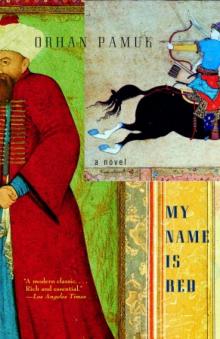 My Name is Red
My Name is Red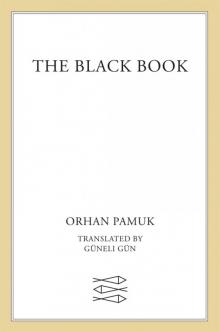 The Black Book
The Black Book The Innocence of Memories
The Innocence of Memories The White Castle
The White Castle Other Colors
Other Colors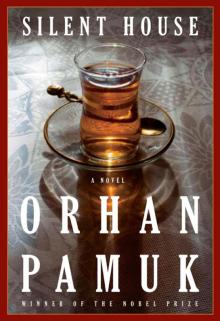 Silent House
Silent House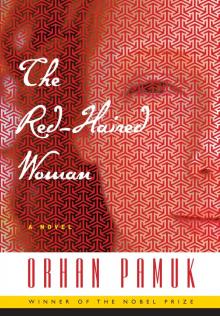 The Red-Haired Woman
The Red-Haired Woman The Museum of Innocence
The Museum of Innocence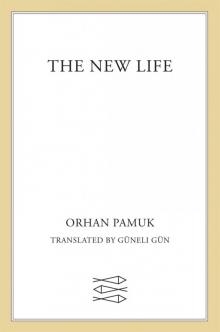 The New Life
The New Life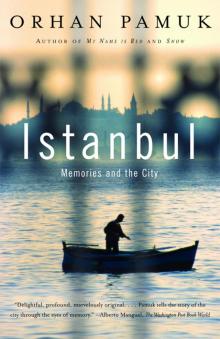 Istanbul
Istanbul